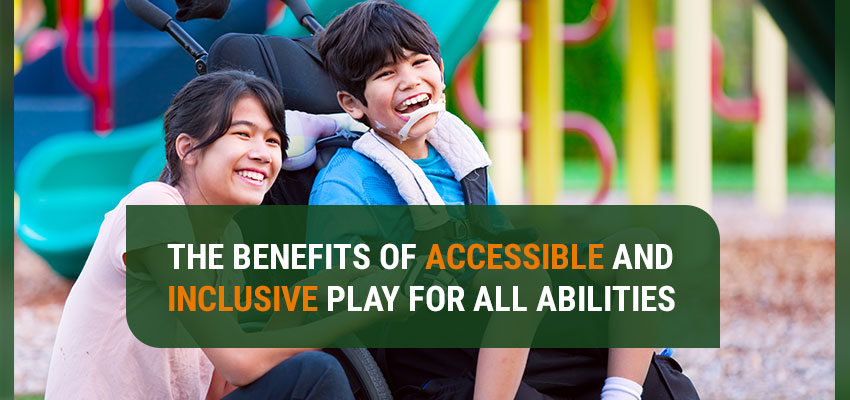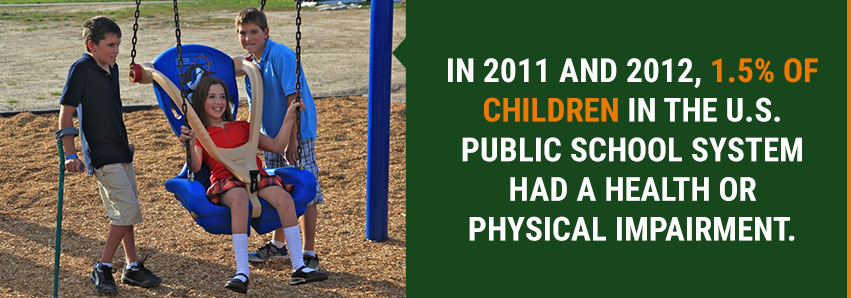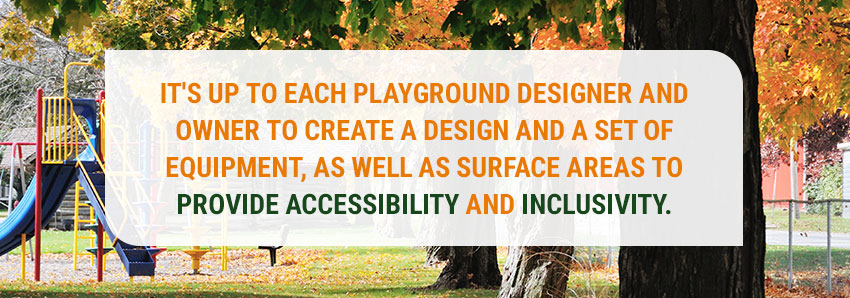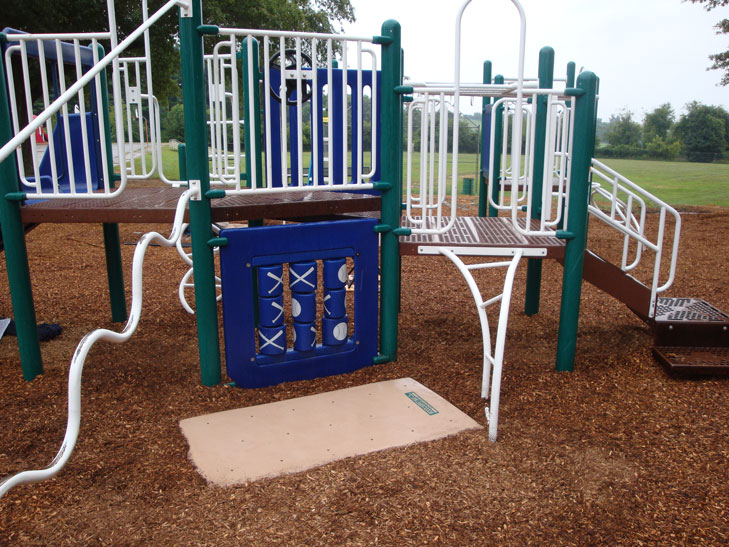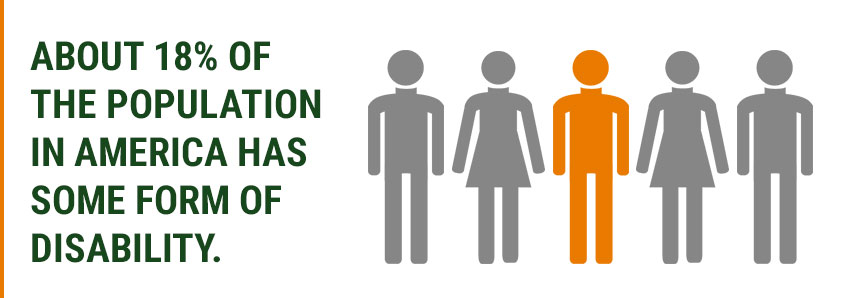In 2011 and 2012, 1.5% of children in the U.S. public school system had a health or physical impairment while 0.9% lived with autism. Children with developmental delays accounted for 0.8% of enrolled children and children with learning disabilities totaled 4.7% of students.
Many children going to school across the country have special needs requiring extra attention. All children have a right to a fun and happy childhood, including safe and enjoyable places to play. Children with special needs have conditions that can affect how they access and experience spaces designed for kids, so it’s important to address their needs.
Since 1990, the Americans with Disabilities Act (ADA) has required public spaces to be accessible to people with special needs and disabilities. Playgrounds, too, must meet ADA accessibility guidelines to ensure children of different abilities can play in these spaces. Going beyond minimum ADA guidelines is important for creating spaces that truly cater to children with special needs and children who develop traditionally. Installing accessible playground equipment, considering adaptive and inclusive designs, and creating a space for all children ensures a healthier playground experience for all.
The Difference Between Inclusive and Accessible
There are play spaces that meet playground accessibility ADA compliance requirements but fail to be truly inclusive. Accessible playgrounds are simply those that can be accessed by people with special needs. They may include playgrounds that permit children in wheelchairs to access some or all of the playground equipment, for example.
Inclusive playgrounds are created for everyone — including children with no known special needs. Truly inclusive playgrounds allow children of all different ability levels to play together.
One of the biggest challenges when installing inclusive or adaptive playground equipment is to consider design first. Rather than having a separate section for special needs children, inclusive playground equipment should be designed to allow able-bodied children, children with physical conditions, and children with different developmental or sensory conditions to all play together on the same equipment, perhaps by using equipment in different ways.
When it comes to guidelines from the ADA, playground equipment of a specific type isn’t recommended. It’s up to each playground designer and owner to create a design and a set of equipment, as well as surface areas to provide accessibility and inclusivity.
The Benefits of Universally Accessible Playgrounds
In some cases, simply installing a wheelchair accessible playground surface is enough to meet ADA playground surfacing requirements, but allowing children onto the surface or onto a few limited pieces of equipment will not truly transform the play experience. A fully accessible playground — one that allows children to experience each piece of equipment differently and allows all children to play together — comes with several benefits:
- Inclusive playgrounds are more fun for kids. Many traditional pieces of playground equipment — such as slides, swings, and jungle gyms — are not inclusive in and of themselves. They’re also pretty basic. When you introduce accessible and inclusive equipment, you are generally installing more creative, unique, and fun equipment for kids. They love exploring new equipment that they don’t see on other playgrounds.
For example, a traditional piece of playground equipment is a basic wood-and-metal slide. Accessible and inclusive slides, however, may be made from textured, brightly colored and plastic materials (to engage eyes and hands) and may include a ramp, ladder, and a rock wall as well as a music panel to allow children who can’t climb ladders to play. The equipment becomes far more engaging because all children can slide, climb, and play in and around this space.
With a unique design and equipment that strays from the typical, your playground may attract more children and be far more enjoyable for everyone.
- Inclusive playgrounds mean inclusive communities. Simply working your way through an ADA compliance checklist and ensuring you have a play area for special needs children or children in wheelchairs isn’t enough. In fact, if you only have a separate area for special needs children, you could be contributing to barriers and making it harder for children with special needs to integrate successfully with their peers.
Playgrounds shouldn’t be divided or segregated. They should be a place for children to come together and learn from each other. Inclusive playgrounds encourage play, which can inspire mutual understanding, friendships, and a real sense of community.
Inclusive playgrounds also offer new opportunities for community building. In school, children with special needs may be placed in different learning environments or in therapeutic day schools rather than traditional classrooms. Interactions between these children and their peers in the same community can be limited, but all kids can meet in communal play spaces. In some cases, playgrounds can be a leveling field where special needs and other labels matter less and children can meet each other on their own terms.
- Inclusive play spaces encourage creativity. Inclusive and accessible play spaces encourage children to play creatively because they include elements to engage all senses and involve equipment that can be used in different ways by different users. An inclusive playground, for example, may have auditory elements so children can make sounds as well as cozy and quiet spaces for children to play quietly. This allows children to engage in a number of different activities and use their imaginations when they play.
Different types of surfacing can also be used to enhance the play experience. For example; using a combination of loose fill and unitary products like using engineered wood fiber which as a different texture and color than say a unitary surface such as poured in place rubber. This can stimulate sight and touch sensory functions in a child’s brain.
How to Make Your Playground Accessible and Inclusive
If your playground has ADA compliant playground surfaces that allow wheelchairs as well as other accessible equipment, you may already meet the minimum standards set by the ADA. However, the minimum may not allow children with special needs to make full use of your space.
You can take several steps to ensure all children can use your playground together:
- Go beyond wheelchair accessible features to include playground equipment for any child with physical conditions. Consider children without arms and children on crutches. Consider children who can walk but have physical conditions preventing jumping, climbing, or running. Install ground-level equipment that can help all children play.
- Include play features for children with motor coordination disorders. Children living with conditions such as Down syndrome can benefit from play features that allow them to assemble objects, turn wheels, or align objects and patterns.
- Add play features for sensory disorders. Children who are on the autism spectrum or have other sensory conditions may find the noise and bustle of the playground difficult. Cozy spaces — such as domes with space underneath them — offer an extra level of play and allow children with sensory disorders a quiet space when they need it. Where possible, place these quiet and cozy spaces away from high traffic equipment and equipment designed to make noise.
- Consider children with visual or auditory impairments. Children with visual and auditory impairments may benefit from textured surfaces they can explore with their hands. They can also benefit from auditory features that allow them to make sounds or music.
- Carefully consider accessibility to and from the playground and between playground equipment. You can install the most accessible equipment in the world, but it won’t mean much if children can’t easily access it. Children with no physical limitations and children using crutches, wheelchairs, and other aids should be able to easily access your playground surface.
The surface should easily absorb shock, especially at areas such as the bottom of slides and underneath swings. In addition, surfacing materials should make it easy for children to get in and out of the playground. You may require a ramp, for example, to help children in wheelchairs roll onto the playground surface.
Engineered wood fiber can be a great option – provided it is installed and maintained properly. Based on a natural material rather than petroleum products, it is shock absorbing, slip resistant, and economical. No matter what surface you use, make sure it meets ADA guidelines and creates a safe area.
When using a loose fill surface such as EWF, installing anchored wear mats at high use areas and even ground level components like the picture above will ensure these play events are accessible for those with disabilities. ADA guidelines require a 48”x30” clear floor space at accessible areas so be sure the mat is at least that size.
Ensure children can move easily between pieces of playground equipment. There should be enough space to allow wheelchairs between the equipment. You should also consider installing different ways to access the same piece of equipment. For example, a ramp or slide along one side of climbing equipment can help children with physical limitations reach the top and slide down again. Climbing areas leading from that surface to another can help children who can use their arms easily access other equipment.
- Offer a wide array of options. Where possible, include numerous options. Install more equipment or more features on each piece of equipment to make it truly adaptive. If you have a large structure, for example, you could build a cozy space underneath it and slides and climbing areas on it, as well as a textured surface section where children can play. The goal is to allow children to play together and use the larger structure as a fort or other creative possibility, ensuring children can play as a group.
- Don’t forget adults. Children with special needs sometimes require caregivers or other adults to supervise closely. Make sure playground equipment is surrounded by enough space for adult supervisors. Include nearby benches or areas where parents can sit and keep an eye on children.
Don’t forget to make adult spaces accessible, too. About 18% of the population in America has some form of disability — and this includes adults. Parking lots, benches for adults, and other areas where adult supervisors might spend time should all be fully accessible.
- Make instructions easy to understand. Consider using pictures and symbols — in addition to words — to explain equipment or safety processes. Try to choose intuitive equipment, so less explanation is needed.
- Consider the playground from a child’s perspective — and ask for feedback. When designing your playground, carefully consider how children with different conditions may experience it. If the playground is busy and contains many colors and auditory equipment, for example, will children on the autism spectrum feel disoriented or left out if there are no cozy spaces or quieter areas? If there is a wheelchair accessible area, will children in wheelchairs feel left out because there is a large sand-only area with attractive equipment?
Consider asking for feedback from parents and children of different abilities. Children can be especially direct about telling you what equipment needs to be changed, moved, or updated for optimum fun. Asking the community to become involved can also build enthusiasm for your project and ensure you have families waiting when you open the space for play.
- Keep equipment engaging and interesting for all. When considering children with special needs, it’s important to ensure play spaces are engaging and interesting for all. Don’t be tempted to buy equipment that is accessible to all, but that’s boring. Similarly, if you find an attractive piece of equipment that all children would love, make sure all children can use it in some way.
Start Today — Create a Welcoming Playground Experience
The number of children with some form of disability has increased about 20% in the past 10 years. Thanks to, children born with disorders have a higher survival rate today. At least 6 million children have a disability of some type, ranging from mild conditions to severe disorders, that impacts their ability to play.
No child should be excluded while their peers have fun on the playground. If you’re responsible for a play space, ensure your area allows children to play together. Your playground should remove barriers that keep children apart based on their abilities. Make a significant impact on entire families and allow all kids to play. The results can be far reaching, helping you build a stronger community, and perhaps permanently change the trajectory of a child’s life.
If you’d like a strong foundation for an accessible playground, start with surfacing. The right surfacing will ensure children of all abilities can easily access your area — whether they’re using a wheelchair or their feet. To ensure your playground stays ADA compliant, use surfacing materials that meet current guidelines.
Wood fiber is an attractive option for most playground designers because it is affordable, versatile, slip resistant, and impact absorbing. While many people consider rubberized surfaces as most accessible to wheelchairs, wood fibers offer amazing benefits and may fit your play space as well or even better.
If you’d like to know more, contact Zeager Bros., Inc. As a leader in engineered wood fiber, we have helped playground designers and builders retrofit older playgrounds and design new playgrounds with wood fiber surfacing designed to be accessible to everyone. Our playground surfacing equipment has been used across the country with terrific results. We’d be happy to help you explore your options for your own play space.

